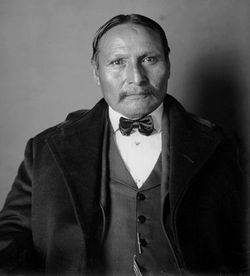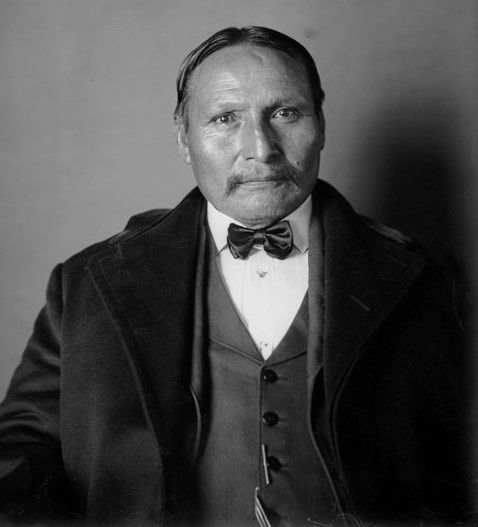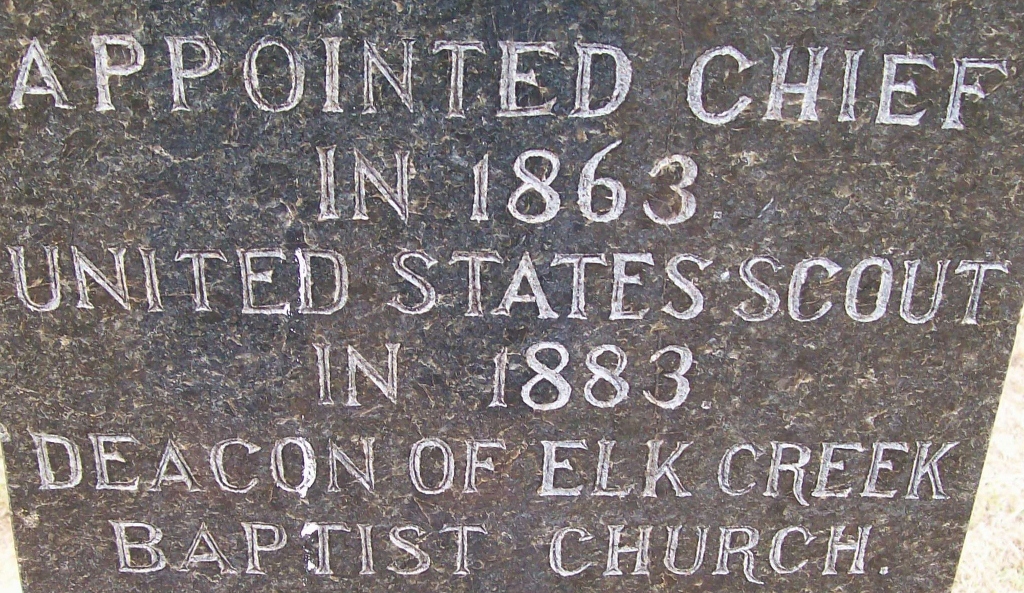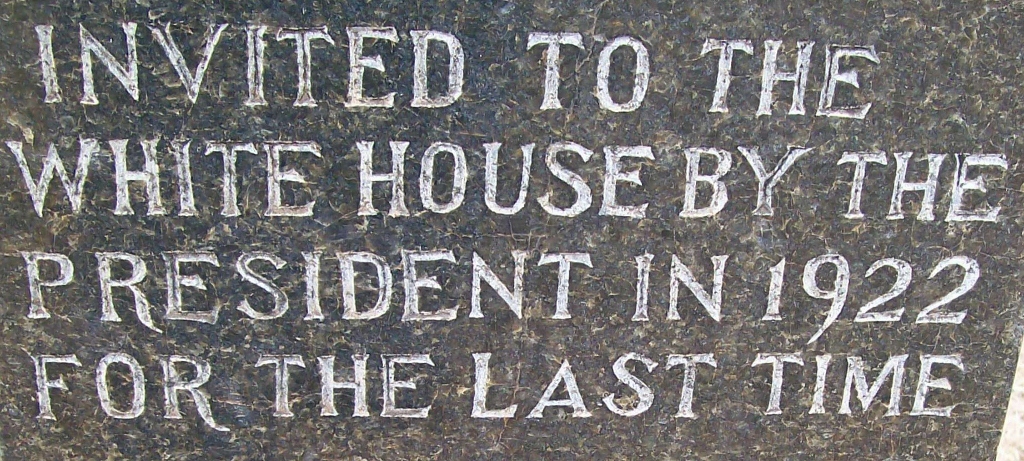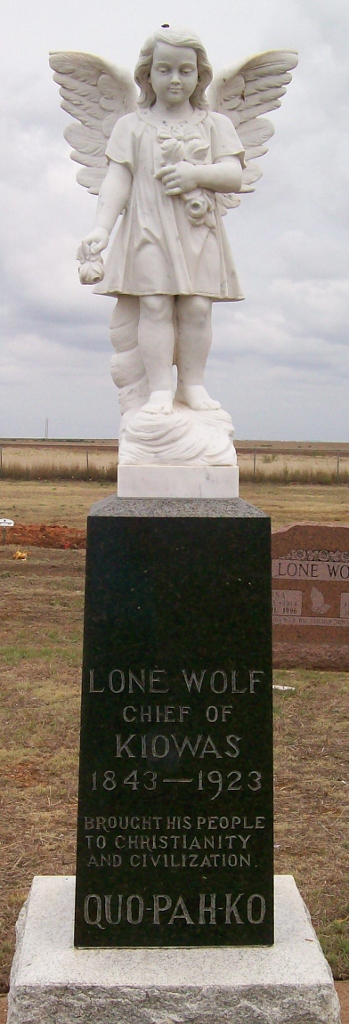Lone Wolf I was (GUI-PAH-GO) The town of Lone Wolf, Texas in Mitchell Co. Texas is named after him. Lone Wolf II (MO-MA-DAY) The town of Lone Wolf, Oklahoma is named after him. The Democrat Chief Hobart, Oklahoma published Lone Wolf II obituary in 1923 giving the details of his death at age 76.
On Dec 23 1873 19 year old Tau-Ah-Kia was killed in South Texas. The only son of (Chief Lone Wolf I,signer of Treaty of Little Arkansas QUO-PAH-KO). Riding in same party at Mitchell Co. Texas was a boyhood friend, Mo-ma-day who retrieved Tau-Ah-Kia his fallen friend and buried him according to Kiowa Custom. Mo-ma-day becoming Chief Lone Wolf II upon the death of his friend Tau-ah-kia.The town of Lone Wolf Oklahoma is named after him.
Lone Wolf I , father of Tau-Ah-Kia, died of Malaria in 1879 and lies buried in an unmarked grave on the north side of Long Horn Mountain east Kiowa County Oklahoma.
In 1874 in Greer County, Lone Wolf II Mo-ma-day, with a band of Comanche warriors fought Major William's men under command of Col. G. F. Buel, in Lone Wolfs last battle with the U. S. Auxiliary chiefs were Gotebo, and Komalty, Ahtape, and Spottedbird. Lone Wolf II bought a suit at El Reno seeking to stop the land opening through an injunction, but Clinton F. Ervin Judge of the Territorial Federal court who tore up the application and denied the request of the Kiowa Chief. Lone Wolf made a trip to Washington, D.C. to see President McKinley hoping to stop the opening of the lottery. However the suit ended in Failure. The Kiowas were given one hundred sixty acres allotments along the Elk Creek bottom lands. Lone Wolf II was like a mighty "Oak" and the last of the recognized chiefs of the Kiowa. After his death there were no real chiefs.In his time Lone Wolf soared to the lofty heights of chieftainship and felt the exhilarating chase of warriorhood. He saw his domain covering Oklahoma, Kansas, Texas and parts of Old Mexico shrink to a mere 160 acre allotment. In boyhood he saw U. S. soldiers forbade the Sundance and the Kiowa warriors withdrew from the banks of the Wichita River. Their medicine lodge was deserted and their sacred Sundance tree left standing alone.
That aborted Sundance held in 1884 is still known to the Kiowas as "The day the forked poles were left standing." The Chief saw a way of life end and a new way of life beginning to take root.
Biography and pictures, furnished by Great Granddaughter Earnestine Kauahquo Kauley daughter of Ernest Kauahquo.
Lone Wolf I was (GUI-PAH-GO) The town of Lone Wolf, Texas in Mitchell Co. Texas is named after him. Lone Wolf II (MO-MA-DAY) The town of Lone Wolf, Oklahoma is named after him. The Democrat Chief Hobart, Oklahoma published Lone Wolf II obituary in 1923 giving the details of his death at age 76.
On Dec 23 1873 19 year old Tau-Ah-Kia was killed in South Texas. The only son of (Chief Lone Wolf I,signer of Treaty of Little Arkansas QUO-PAH-KO). Riding in same party at Mitchell Co. Texas was a boyhood friend, Mo-ma-day who retrieved Tau-Ah-Kia his fallen friend and buried him according to Kiowa Custom. Mo-ma-day becoming Chief Lone Wolf II upon the death of his friend Tau-ah-kia.The town of Lone Wolf Oklahoma is named after him.
Lone Wolf I , father of Tau-Ah-Kia, died of Malaria in 1879 and lies buried in an unmarked grave on the north side of Long Horn Mountain east Kiowa County Oklahoma.
In 1874 in Greer County, Lone Wolf II Mo-ma-day, with a band of Comanche warriors fought Major William's men under command of Col. G. F. Buel, in Lone Wolfs last battle with the U. S. Auxiliary chiefs were Gotebo, and Komalty, Ahtape, and Spottedbird. Lone Wolf II bought a suit at El Reno seeking to stop the land opening through an injunction, but Clinton F. Ervin Judge of the Territorial Federal court who tore up the application and denied the request of the Kiowa Chief. Lone Wolf made a trip to Washington, D.C. to see President McKinley hoping to stop the opening of the lottery. However the suit ended in Failure. The Kiowas were given one hundred sixty acres allotments along the Elk Creek bottom lands. Lone Wolf II was like a mighty "Oak" and the last of the recognized chiefs of the Kiowa. After his death there were no real chiefs.In his time Lone Wolf soared to the lofty heights of chieftainship and felt the exhilarating chase of warriorhood. He saw his domain covering Oklahoma, Kansas, Texas and parts of Old Mexico shrink to a mere 160 acre allotment. In boyhood he saw U. S. soldiers forbade the Sundance and the Kiowa warriors withdrew from the banks of the Wichita River. Their medicine lodge was deserted and their sacred Sundance tree left standing alone.
That aborted Sundance held in 1884 is still known to the Kiowas as "The day the forked poles were left standing." The Chief saw a way of life end and a new way of life beginning to take root.
Biography and pictures, furnished by Great Granddaughter Earnestine Kauahquo Kauley daughter of Ernest Kauahquo.
Bio by: Claudia L Naugle
Inscription
Brought his people to Christianity and Civilization. Quo Pah Ko appointed chief in 1883. United States Scout in 1883. Deacon of Elk Creek Baptist Church. Invited to the White House by the President in 1922 for the last time.
Gravesite Details
you will find QUO-PAH-KO on Chief MO-MA-Day Lone Wolf II headstone-- it is not his name, it is a Indian word for the meaning of BAND Of INDIANS who were at the Treaty of Arkansas. The Treaty of Arkansas is called QUO-PAH-KO.
Family Members
Advertisement
